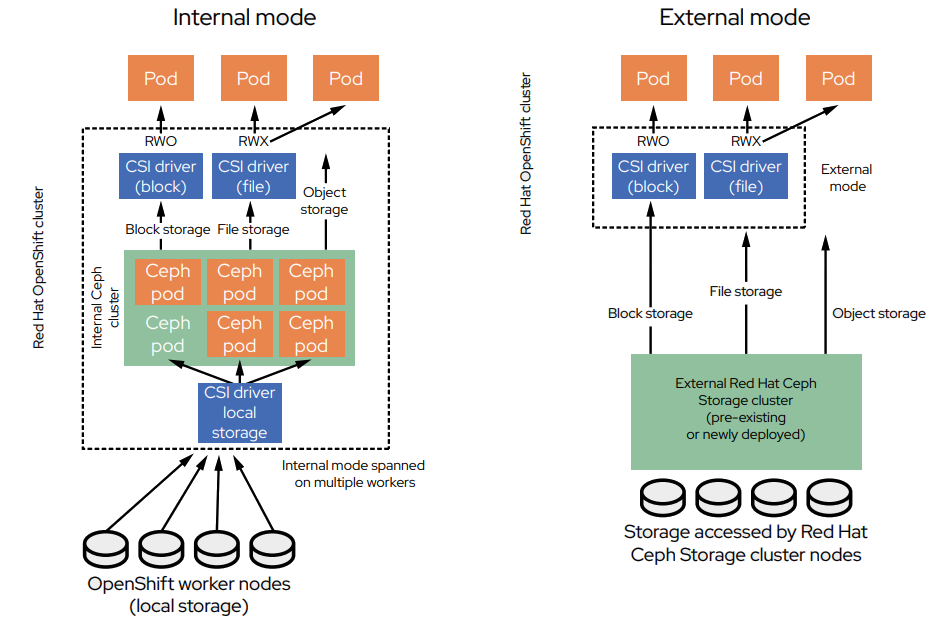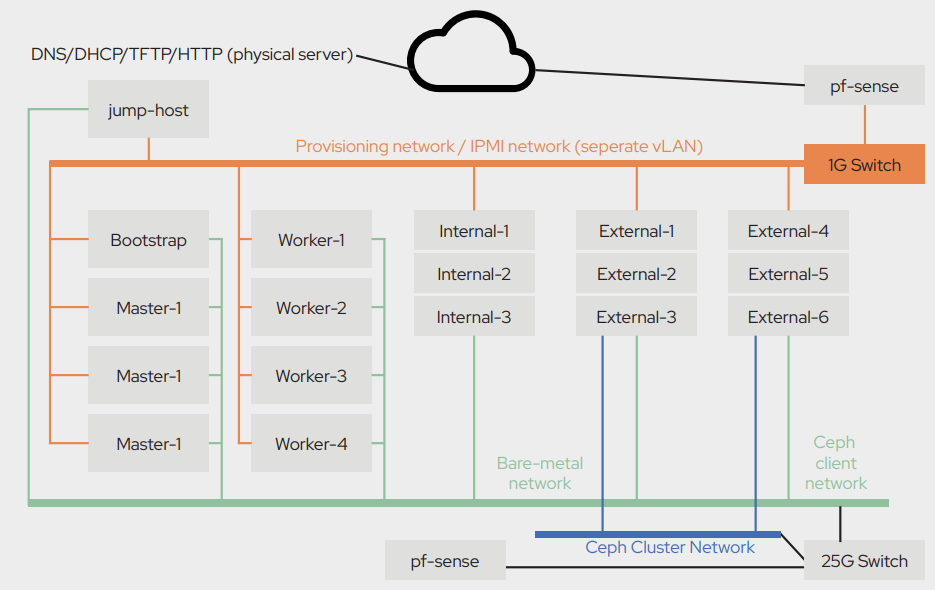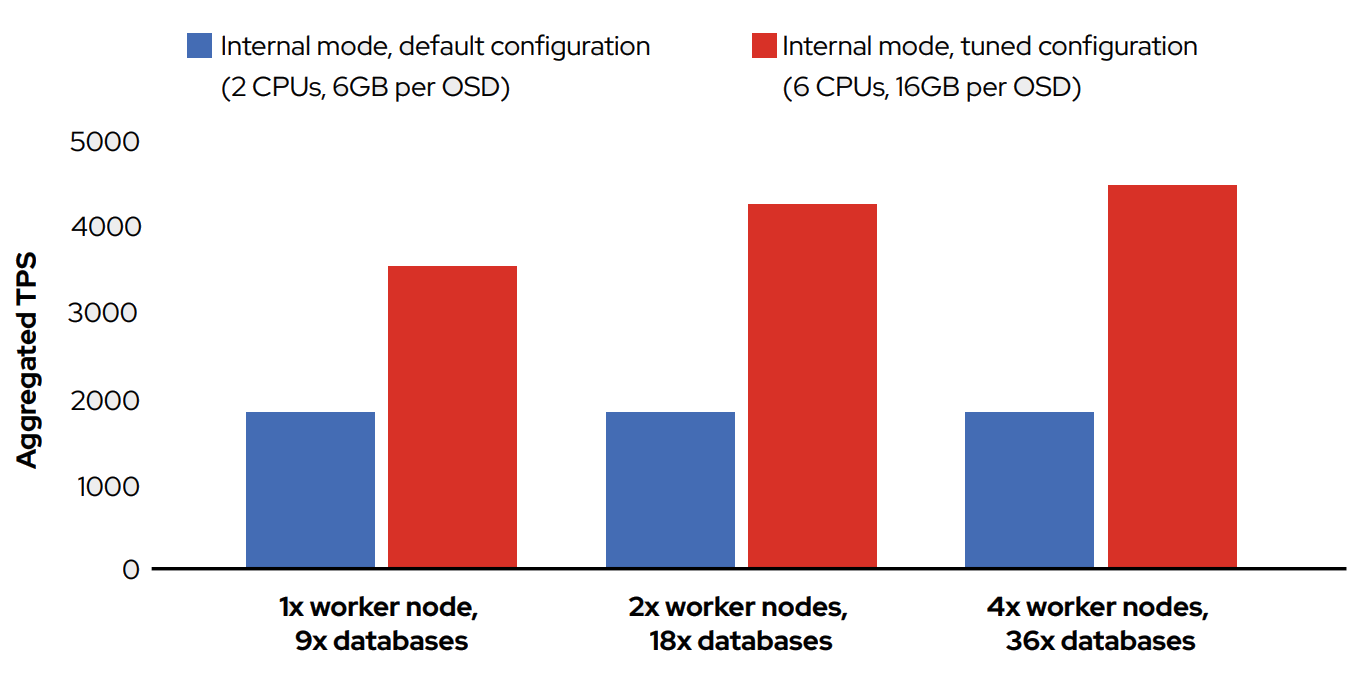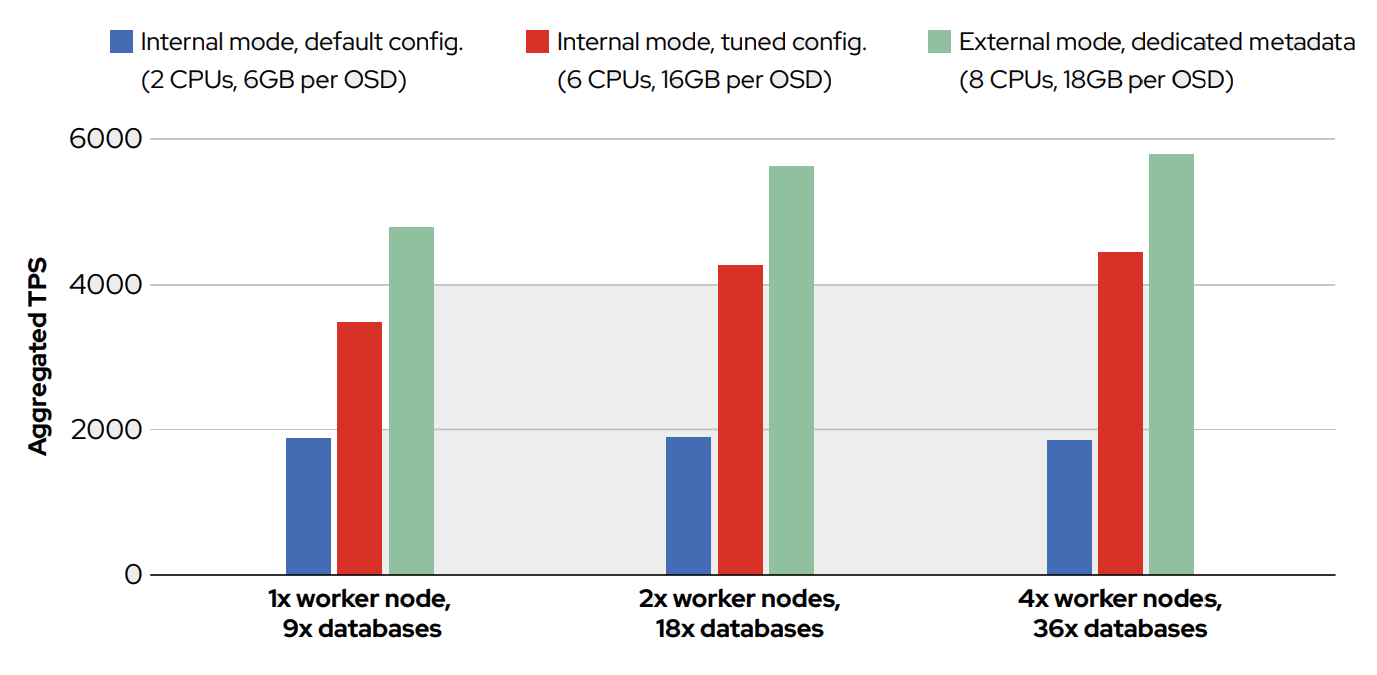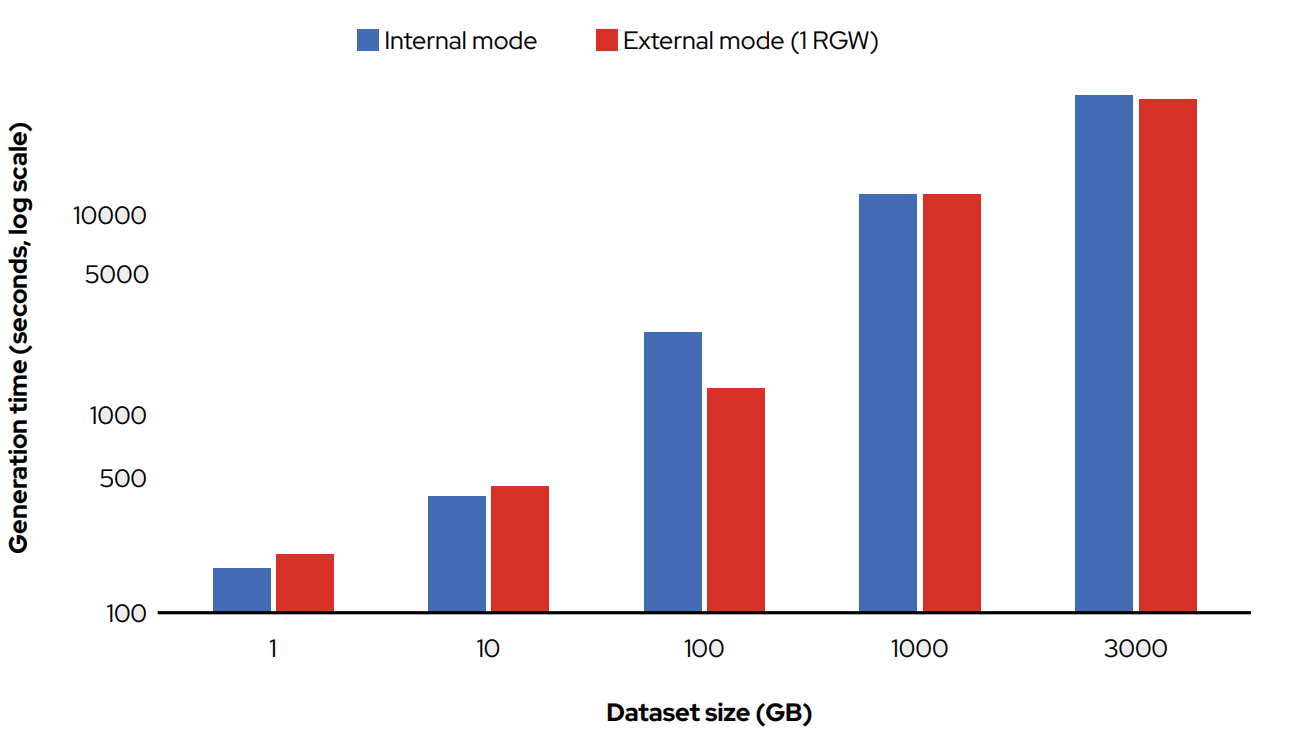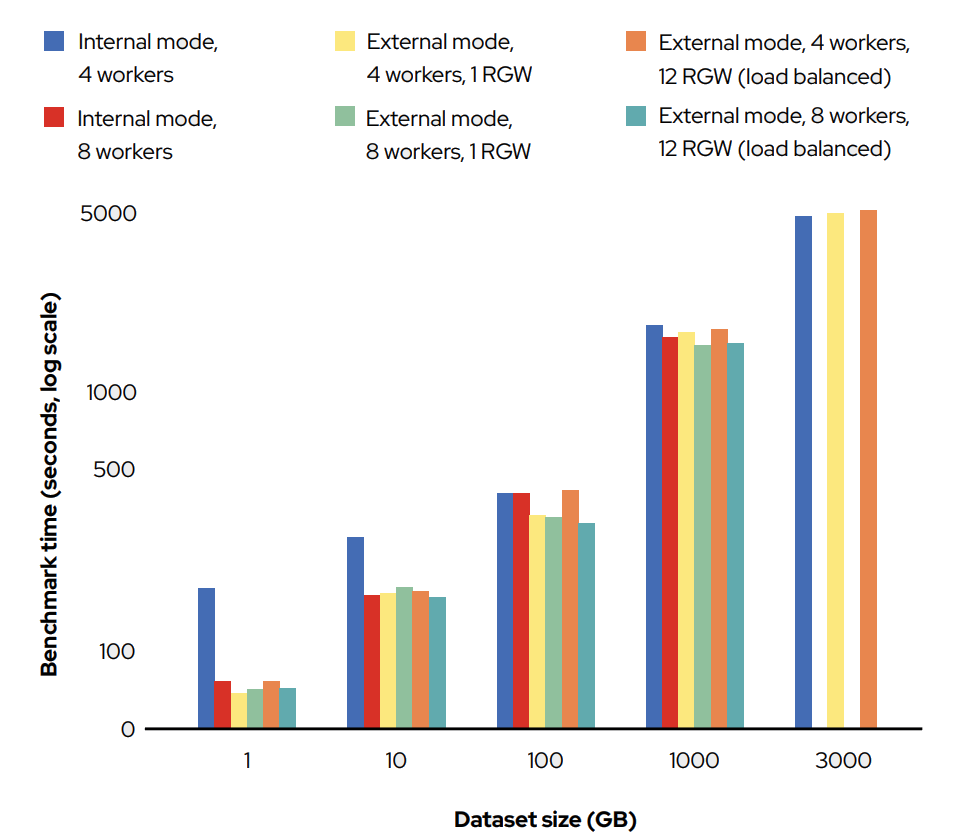Red Hat OpenShift Data Foundation for database and analytics
Executive summary
Hybrid cloud and container environments managed by Kubernetes are placing increased focus on cloud-native storage. Developers and data scientists need to architect and deploy container-native storage rapidly and per their organization’s governance needs. They need the ability to launch their data-intensive apps and machine learning (ML) pipelines where it makes sense within the hybrid cloud, with a fundamental assumption of consistent data storage services. Those services must be inherently reliable and able to scale both in capacity and performance independent of the applications they support.
Red Hat® OpenShift® Data Foundation now offers solution architects multiple deployment options to suit their specific needs. Traditional internal mode storage offers simplified management, deployment speed, and agility by deploying OpenShift Data Foundation pods within the Red Hat OpenShift Data Foundation cluster. OpenShift Data Foundation external mode1 supports Red Hat Ceph® Storage clusters that are separate and independent from the Red Hat OpenShift Data Foundation cluster that consumes the storage. OpenShift Data Foundation external mode option can serve multiple purposes, including:
- Providing centralized storage for multiple Red Hat OpenShift Container Platform clusters.
- Scaling or tuning Red Hat Ceph Storage outside the specifications available within an internal mode OpenShift Data Foundation cluster.
- Utilizing an existing Red Hat Ceph Storage cluster.
- Sharing a Red Hat Ceph Storage cluster between multiple Red Hat OpenShift Container Platform clusters.
To characterize performance for different OpenShift Data Foundation modes, Red Hat engineers deployed both database and analytics workloads on a Red Hat OpenShift Container Platform cluster built with the latest Intel Xeon processors and Intel solid state drive (SSD) technology. For PostgreSQL testing, the external Red Hat Ceph Storage cluster achieved greater performance and scalability, aided by high-performance Intel Optane SSD Data Center (DC) Series for storing Ceph metadata. For less I/O-intensive analytics workloads, testing showed that both internal and external mode configurations provided roughly equal performance when normalized for the number of drives
OpenShift Data Foundation internal and external mod deployment options
Earlier releases of OpenShift Data Foundation were focused on a fully containerized Ceph cluster run with a Red Hat OpenShift Container Platform cluster, optimized as necessary to provide block, file, or object storage with standard 3x replication. While this approach made it easy to deploy a fully integrated Ceph cluster within a Red Hat OpenShift environment, it presented several limitations:
- External Red Hat Ceph clusters could not be accessed, potentially requiring redundant storage.
- A single OpenShift Data Foundation cluster was deployed per Red Hat OpenShift Container Platform instance, so the storage layer could not be mutualized across multiple clusters.
- Internal mode storage had to respect some limits in terms of total capacity and number of drives, keeping organizations from exploiting Ceph’s petabyte-scale capacity.
OpenShift Data Foundation external mode overcomes these issues by allowing OpenShift Container Platform to access a separate and independent Red Hat Ceph Storage cluster (Figure 1). Together, with traditional internal-mode storage, solutions architects now have multiple deployment options to address their specific workload needs. These options preserve a common, consistent storage services interface to applications and workloads, while each provides distinct benefits:
- Internal mode schedules applications and OpenShift Data Foundation pods on the same Red Hat OpenShift cluster, offering simplified management, deployment, speed, and agility. OpenShift Data Foundation pods can either be converged onto the same nodes or disaggregated on different nodes within the cluster, allowing organizations to balance Red Hat OpenShift compute and storage resources as they like.
- External mode decouples storage from Red Hat OpenShift clusters, allowing multiple Red Hat OpenShift clusters to consume storage from a single, external Red Hat Ceph Storage cluster that can be scaled and optimized as needs dictate.
Workloads and cluster configuration
Because OpenShift Data Foundation internal and external mode architectures differ in component configuration, data path, and networking, Red Hat engineers wanted to verify that they provide the same predictable and scalable Ceph performance across multiple workloads.
Workload descriptions
To help guide organizations with architectural choices, Red Hat engineers wanted to compare the performance of two types of workloads — databases and analytics — across both internal- and external-mode configurations. The following workloads were evaluated:
- Database workload. The database workload consisted of multiple PostgreSQL database instances queried by a Sysbench multithreaded workload generator tool called Sherlock. The workload uses a block-based access method, and the principal measurement metric is aggregated transactions per second (TPS) across all databases.
- Analytics workload. The analytics workload consisted of a selection of 56 I/O-intensive workloads from the TPC-DS benchmark, run by Starburst Enterprise. This workload exercised object performance, with the primary metric being the time taken to complete all the queries (execution time).
Cluster configuration
Both workloads were run on the same Red Hat OpenShift Container Platform cluster, configured alternately with internal mode and external mode (Table 1 and Figure 2). The two configurations were chosen based on the following criteria:
- Internal mode OpenShift Data Foundation clusters are deployed within a Red Hat OpenShift cluster, either integrated within the same worker nodes that are serving other applications, or, as in this case, disaggregated on infrastructure nodes to provide separate application and data scalability. A three-node OpenShift Data Foundation configuration was used for internal mode testing.
- External mode storage clusters are massively scalable, support mixed media types, expanded tuning options, and are able to support multiple Red Hat OpenShift clusters. A six-node OpenShift Data Foundation cluster was used for external-mode testing, with different numbers of nodes used for different tests. The external mode configuration also evaluated placing Red Hat Ceph Storage metadata on separate high-performance Intel Optane SSDs.
Table 1. Test cluster with internal mode and external mode storage plane options
| Control plane | Compute plane | Storage plane | ||
| Resources | Helper node, bootstrap node, Red Hat OpenShift Container Platform master node | Red Hat OpenShift Container Platform worker nodes | OpenShift Data Foundation internal cluster nodes | OpenShift Data Foundation external cluster nodes |
| Node count | 1+1+3 | 4 | 3 | 6 |
| Memory | 192GB | 256GB | 192GB | 192GB |
| Metadata drives | N/A | N/A | 2x Intel SSD D5-P4320 Series (7.68TB, 2.5- inch, PCIe 3.1 x4, 3D2, QLC) | 2x Intel Optane SSD DC P4800X Series (750GB, ½ height PCIe x4, 3D XPoint) |
| Data drives | N/A | N/A | 8x Intel SSD D5-P4320 Series (7.68TB, 2.5-inch PCIe 3.1 x4, 3D2, QLC) | |
| Red Hat OpenShift cluster network | 1x 25Gb Ethernet | 1x 25Gb Ethernet | 1x 25Gb Ethernet | |
| Operating system | Red Hat Enterprise Linux® CoreOS | Red Hat Enterprise Linux® CoreOS | Red Hat Enterprise Linux® CoreOS | Red Hat Enterprise Linux 8.2 |
| Red Hat OpenShift Container Platform version | 4.5.2 | 4.5.2 | 4.5.2 | N/A |
| OpenShift Data Foundation version | N/A | N/A | 4.52 | 4.5 |
Intel Xeon processors and SSDs
Intel technologies played a significant role in Red Hat testing. The test cluster employed Intel Xeon Scalable processors and Intel Solid State Drive (SSD) technology, including:
Intel Xeon processor E5 family. Designed for architecting next-generation data centers, Intel Xeon processor E5 family delivers versatility across diverse workloads in the datacenter or cloud. The Red Hat OpenShift Container Platform cluster under test ran on servers powered by Intel Xeon processor E5-2699 v4.
Intel Xeon Scalable processors. OpenShift Data Foundation used servers equipped with two Intel Xeon Gold 6142 CPUs. These processors deliver workload-optimized performance and advanced reliability with the highest memory speed, capacity, and interconnects.
Intel SSD D5-P4320 Series. Intel SSD D5-P4320 Series were used as combined data and metadata drives for the internal-mode testing, and as data drives for the external-mode testing. As the industry’s first PCIe-enabled QLC drive for the datacenter, the Intel SSD D5-P4320 Series delivers big, affordable, and reliable storage. With 33% more bits than TLC, the Intel QLC NAND SSDs enable triple the storage consolidation compared to hard disk drives (HDDs), leading to lower operational costs.
Intel Optane SSD DC P4800X Series. For maximum scalability and reliability, Intel Optane SSD DC P4800X Series were used for metadata storage in external-mode testing. Hosting metadata on high-speed storage is an effective means of enhancing Red Hat Ceph Storage performance. The Intel Optane SSD DC P4800X represents an ideal storage tier that provides high performance, low latency, and predictably fast service to improve response times. Important for Ceph metadata, the Intel Optane SSD DC P4800X Series provides high endurance suitable for write-intensive applications like online transaction processing (OLTP). Able to withstand heavy write traffic, the Intel SSD DC P4800X Series is ideal for a Red Hat Ceph Storage cluster utilized by OpenShift Data Foundation external mode.
PostgreSQL testing
To evaluate database performance within Red Hat OpenShift Container Platform, engineers employed PostgreSQL on the test cluster, measuring performance using both OpenShift Data Foundation internal mode and external mode. Testing simulated multiple databases being queried by multiple clients for a variety of query types. To generate the workload, open source Sherlock scripts were used to launch multiple PostgreSQL databases and to exercise them using the scriptable Sysbench multi-threaded benchmark tool.
Default and tuned OpenShift Data Foundation internal-mode testing
Even within a Red Hat OpenShift Container Platform cluster, tuning options can result in performance gains for data-intensive applications like PostgreSQL. Engineers compared a default OpenShift Data Foundation configuration with a tuned configuration. The two internal-mode configurations were equipped as follows:
- Default configuration. 2x CPUs, 6GB per Ceph object storage daemon (OSD)
- Tuned configuration. 6x CPUs, 16GB per Ceph OSD
Figure 3 shows that aggregated TPS across all of the database instances was dramatically higher with the tuned configuration than with the default configuration. Moreover, performance in the tuned configuration scaled nicely as the number of worker nodes and PostgreSQL databases quadrupled while performance for the default configuration remained roughly the same. These results demonstrate that tuning can use high-performance devices such as Intel SSD D5-P4320 Series to achieve higher storage performance for PostgreSQL.
Comparing OpenShift Data Foundation internal and external modes
Engineers then compared the same two internal-mode performance results with an OpenShift Data Foundation external mode configuration, using the external Red Hat Ceph Storage cluster.2 For the external-mode cluster, resources were increased to 8 CPUs and 18GB per OSD. Ceph metadata was stored on two Intel Optane SSD DC P4800X on each server.
The resulting performance testing yielded higher aggregated TPS above the tuned internal-mode configuration for a given number of databases (Figure 4). PostgreSQL performance also scaled as the number of worker nodes and databases was quadrupled.
TPC-DS testing
The TPC Benchmark DS (TPC-DS) is a standardized benchmark that provides a representative evaluation of performance as a general-purpose decision support system. It includes data sets and queries that allow benchmarking of infrastructure by reporting query response times. This test is a good fit for simulating analytics workloads in a reproducible and objective manner. Out of the 100 queries provided by TPC-DS, Red Hat engineers selected 56 of the most I/O-intensive queries to evaluate OpenShift Data Foundation.
Starburst Enterprise
In Red Hat testing, the selected TPC-DS queries were run by Starburst Enterprise—a modern solution built on the open source Trino (formerly known as PrestoSQL) distributed SQL query engine.. It harnesses the value of open source Trino, the fastest distributed query engine available today. Trino was designed and written for interactive analytic queries against data sources of all sizes, ranging from gigabytes to petabytes. Starburst Enterprise approaches the speed of commercial data warehouses while scaling dramatically.
The Starburst Enterprise platform provides distributed query support for varied data sources, including:
- NoSQL systems (MongoDB, Cassandra, Redis)
- SQL databases (Microsoft SQL Server, MySQL, PostgreSQL)
- Data warehouses (IBM Db2 Warehouse, Teradata, Oracle Exadata, Snowflake)
- Hive (HDFS, Cloudera, MapR)
- Data services (Kafka, Elasticsearch, OpenShift Data Foundation)
TPC-DS data generation
Before the TPC-DS queries could be run, the cluster needed to be populated with data. The data generation methodology applied was the same for both OpenShift Data Foundation internal mode and external mode, as follows:
- A Trino cluster was deployed on the worker nodes using the Starburst Enterprise Kubernetes operator (running on four nodes).
- Eight Trino workers with 40 CPUs (fixed number, request=limit) and 120GB of RAM were used to generate the data, using the TPCDS connector included with Starburst Enterprise . This connector creates synthetic data sets at various scale factors (data set sizes).
- The data sets created were of various sizes (1GB, 10GB, 100GB, 1TB, 3TB), and creation time was measured for each of these.
Figure 5 illustrates data generation times measured on both the internal-mode cluster and the external-mode cluster. In general, data generation times were found to be highly similar for the two storage options.
TPC-DS query performance
Once the data was generated, engineers ran the subset of 56 TPC-DS queries with the two different Trino configurations against the data sets created on the OpenShift Data Foundation internal-mode and external-mode clusters. Engineers used two configurations to run the queries:
- Eight Trino workers with 40 CPUs and 120GB of RAM
- Four Trino workers with 80 CPUs and 240GB of RAM
For the OpenShift Data Foundation external mode tests, two different configurations of RADOS Gateway (RGW) access were then tested: a single RGW as an S3 endpoint, and 12 RGWs behind a load-balancer acting as the S3 endpoint. As shown in Figure 6, external mode test runs generally performed at parity or slightly better than the results from all of these runs, demonstrating that organizations can reap the benefits of OpenShift Data Foundation external mode without sacrificing performance.
Conclusion
Data scientists and cloud-native app developers need their apps to work the same, wherever they are on the hybrid cloud, without variability in storage services capabilities. By offering a choice of internal-mode and external-mode storage for OpenShift Data Foundation, Red Hat gives organizations the flexibility they need without sacrificing performance.
Optimized external mode configurations can help data-intensive apps like those based on PostgreSQL to improve performance and scale predictably as the number of worker nodes and databases grows. For less data-intensive applications such as the TPC-DS queries evaluated herein, organizations can enjoy the flexibility of external mode operation without compromising performance.
External mode is available with Red Hat OpenShift Data Foundation 4.5 or later. See the OpenShift Data Foundation documentation for more information.
Though the external Red Hat Ceph Storage cluster contained six nodes, engineers only used three nodes for performance testing in the interest of consistency with the internal-mode tests.

